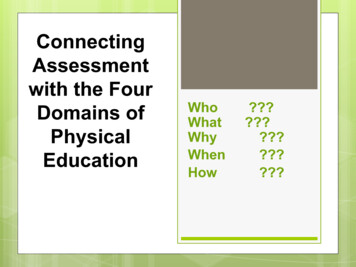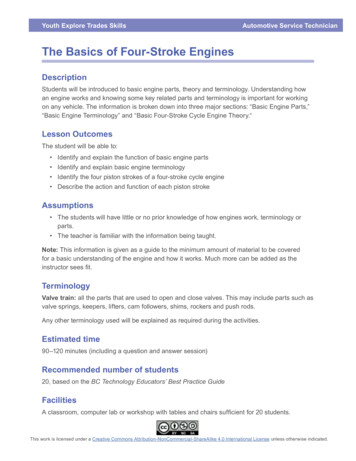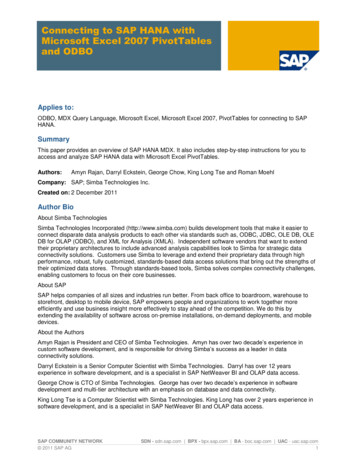
Transcription
ConnectingAssessmentwith the FourDomains ofPhysicalEducationWhoWhatWhyWhenHow?
Question 1:Why Assess inPhysical Education ? Forces teachers to look carefully at each student Determine if program is instructionally aligned Understand the progress students are making Accountability measure for students and teachers
What Purpose DoesAssessment Serve? Guides and directs instruction.Provide students info on their progress.Motivate students to improve their performance.Collect objective information on students for gradingpurposes.Make judgment about the effectiveness of teaching.Evaluate the curriculum or program
What is Assessment The measurement or collection of informationregarding the student performance of skills,knowledge, and attitudes taught in physicaleducation classes Assessment should answer the questions: “What does this student value, understand andwhat are they able to do?” Instructionally- assessment should answer thequestion “ What does the student need to learnnext?”
There are 2 types of assessmentperformed in Physical EducationInformal assessments (formative)- done toobtain knowledge about student performance- thisshould direct your teachingFormal assessment (summative)- intent to affectgrading procedures
What are we assessing?As physical educators we are assessing in four domainso Cognitive domain - what students know and understando Health-related physical fitness- improvements in fitness levelso Psychomotor-skills- what students are able to do and performo Affective domain - attitudes and beliefs about the subjectList 2 assessment examples for each domain
Let’s Look at the SHAPE AmericaStandard 1The physically literate individual demonstratescompetency in a variety of motor skills andmovement patterns.Standard 2The physically literate individual applies knowledge ofconcepts, principles, strategies and tactics related tomovement and performance.Standard 3The physically literate individual demonstrates theknowledge and skills to achieve and maintain a healthenhancing level of physical activity and fitness.Standard 4The physically literate individual exhibits responsiblepersonal and social behavior that respects self andothers.Standard 5The physically literate individual recognizes the value ofphysical activity for health, enjoyment, challenge, selfexpression and/or social interaction
Two types: formative and summativeIs there a difference?Formal assessmentThis should assess daily lesson goals and drive your instruction.Formative assessment does the following: Involves the students in the process of assessment and goal settingMotivates students to improve their performanceProvides feedback for teaching effectivenessProvides teachers information on current student status in relation to learningobjectivesPlaces students in appropriate instructional groupsProvides teachers with objective information for gradingMaximizes probability of instructional alignments (SHAPE America)
Summative AssessmentThis should reflect student achievement of unit goals.This is your end product. Post Skills TestsEnd of unit presentationsWritten TestsPortfoliosClass ProjectsJournalsSkill LabsFitness Logs
Formative1. Assessment for learning: These ongoing assessments help students learn byproviding feedback that leads to goal setting and improvement. They also help youadjust instruction to meet the students’ needs.(Lund and Veal, 2013)Assessment for learning falls into the formative domain because they help studentsreview skills or concepts previously taught, by providing feedback about their progress inmeeting the learning outcomes. This helps to put the ownership of individual and peerlearning on the students, therefor making them accountable for their actions.Most formative assessments are not graded because they are usually done by students asself-assessments or peer- assessments. Any formative assessments used for gradingshould be teacher-directed.If the results of the assessment are used by the teacher to make instructional decisions orif the results are communicated to students to improve learning, formative assessmenthas occurred. (Lund and Veal, 2013)
2. Assessment of learning: These assessments are used for grading. Theyare final because there is no chance for the teacher to adjust for the learners toimprove. (Lund and Veal, 2013)This type of assessment falls into the summative domain because thestudents have been taught the skills during the lessons and have had plenty ofopportunities to reflect upon their performance and practice the skills neededto improve upon their performance.Summative assessments are used to determineeach individual student’s growth by the end ofthe unit.
Why isaffectiveassessmenteffective?AffectiveAssessment
Affective assessment deals with students perceptions ,values, interests, attitudes, feelings .The affective domain encompasses the feelings,attitudes, and dispositions that students have towardsomething.For physical educators that “something” involvesparticipating in physical education while demonstratingresponsible personal and social behavior (SHAPEAmerica Standard 4)and understanding that physicalactivity provides opportunities for enjoyment, challenge,self-expression and social interaction (SHAPE AmericaStandard 5).
When the affectivedomain is assessedproperly it measuresthe development ofacceptable social andpersonal behaviors.The affective domain allows you tohave students self-assess to reflectupon their own behavior.By doing this itbecomes instantfeed backfor the studentsso that they canset goals for theirown improvement.
Why should we assess in the affective domain?1. Your students need to know what behaviors you consider important and thatyou will be holding them accountable for their actions.Common behavior traits include,Effort (willingness to participate)Fair play (sportsmanship)Willingness to cooperate (teamwork)These traits may represent different things to different people, therefore it is up toyou to decide what the most important traits/behaviors are for your classes.
2. If students care about others and act in ways to show that they care thenthe class will function more efficiently and effectively.When affective temperaments are assessed you will be able todirect your students towards becoming more responsible youngadults therefore improving the emotional climate of your classes.
How do we assess in the affective domain?First, you need to define the behavior.Next, identify the actions that are acceptableindicators of students meeting your expectationsfor the trait/behavior being assessed.Once you have the behaviors and acceptableindicators you can utilize checklists, rating scales,rubrics, journals, event recording, exit slips,anecdotal records and written tests.The next few slides will show some examples* of these types of affectiveassessments.(* All examples of assessments are from ; Assessment-Driven Instruction in Physical Education byJacalyn Lund and Mary Lou Veal )
Levels of Responsibility ChecklistName: Date:Class period:Directions: Check each of the behaviors you used in today’s class.My respect:I did not make fun of others.I did not hog the equipment.I did not interfere with others.I did not interrupt when someone was talking.My participation:I followed all directions.I tried my best.I avoided people who were trying to cause trouble.I let others participate.My self-direction:I encouraged others.My teacher did not need to remind me to keep practicing.Even though I saw someone doing something wrong, I chose to mind my own business.My caring:I tried to help others.I helped my teacher.I gave someone a compliment.My improvement goal is:
Badminton Peer AssessmentYour name:Opponent’s name:Use this form to assess the etiquette of your opponent's. Circle 1 if the statement is not at all true,2 if it is true some of the time, or 3 if it’s true most of the time. Please answer each question fairlyand accurately. This assessment is not part of the grade.Never trueSometimestrueTruemost ofthe timeEncourages others (says things like “nice shot”, “goodhustle”, and so on)123Wins or loses gracefully (doesn't throw temper tantrums)123Both partners on the other team played equally (theperson being rated by you did not hog the court and tryto dominate the play)123Correct calls were made; they didn’t try to cheat.123Courteous to others (We really enjoyed playing the otherteam because they were so nice)123
BehaviorUnacceptablePassingTargetExemplarySafetyIs aware of or ignorespotentially dangeroussituations: participatesrecklessly with littleconcern for othersIs cautious while participating;when learning somethingnew, waits for assistancewhen appropriate; avoidsgetting hurt or usingbehaviors that could harmothersUses equipment in a safeconscientious manner; stopsparticipating if there ispotential danger and tellsothers so that the situationcan be corrected.Alerts others to potentialsafety hazards; isconstantly on the lookoutfor potential safetyproblems and seeks tocorrect those with easyfixes.On taskbehaviorConstantly modifies a taskand does not practice asthe teacher instructs; talkswith friends instead ofparticipating; moves to theend of the line to avoidtaking turns.Stays on task usually withouta reminder or prompt from theteacher or another person.Practices tasks that theteacher specifies; continuesto practice even whenhaving limited success.When encountering a taskthat is too easy or hard,requests modification fromthe teacher; encouragesothers to stay on task.EffortCompletes task with littlepersonal exertion orenthusiasm.Completes tasks in asatisfactory manner; doesactivities expected byteacher.Is engaged in all activitiesmentally and physically;others can count on thisstudents performance; givesone’s best performance;shows persistence whentask is difficult.TeamworkHogs the ball; fails tosupport others; seeks todominate play.Works with others to achievesuccess for the team;communicates with others toensure group success.Encourages goo play byothers; allows others toexperience success.Demonstrates leadershipand the strong desire forall students to worktogether to accomplish atask; willing to experiencepersonal sacrifice for thegood off the team.
Journal (Prompts)Name: Date:1.Did all members of your team have a chance to be successful? Explain your role in makingthat happen. If it did not happen, what could you have done to change things?2.How did you help or encourage someone else today?3.What skills do you feel confidents about and which ones do you struggle doing?4.How could someone help you participate at a more competent level?5.If you had someone on your team who wasn’t very skilled, how could you make this personfeel welcomed?6.What was your favorite part of the unit?
Event RecordingBehavioral Recording SheetNamesUnsafebehaviorHelped XXXXT-Chart Template for Recording BehaviorsName of StudentThis would be a full page.Compliments SeenCompliments Heard
Anecdotal RecordsName of Student:Julie SnowClass period: 2ndSemester/marking period: 3rd quarter 2012Comments:3-1: Julie assisted a special needs student in class today; after her help,others in class started helping as well; demonstrated good leadership.3-15: Julie refused to participate; she was placed on a team with studentsthat she did not like and opted to sit out; I tried to encourage her, but sherefused to participate.
Written testsName:Date:1. You are practicing hitting with a 5-iron with your physical education class. You have hit yourballs. The best thing to do is:a.b.c.d.allotment ofHelp your neighbor hit any remaining balls.Move around class and give feedback to others.Remain at your designated spot and wait for others to finish.Go to the bulletin board to check the elements of correct form for your swing and do some practice swings.2. You are still practicing with your 5-iron. Following one of your swings, it slips out of your hands, landing on thehitting range. You should:a.b.c.d.Yell at others to stop hitting an run out to retrieve your club.Run out and quickly retrieve your club.Move around class to give e feedback to others.Wait until everyone has completed hitting their balls before retrieving the club.3. According to golf etiquette, when on the putting green, the player who putts first is:a.b.c.d.The player whose ball is furthest from the hole.The player who is the oldest.The first person to have his or her ball hit the green.The player whose ball is closest to the hole.
What type of activities highlightthe affective domain? Project Adventure activitiesTeam building activitiesTeam Sports Model
Cognitive Domain mental skills (knowledge)knowledge: identify, define, repeat, recognizecomprehension: restate, explain, discuss, describe, illustrate application: develop, translate, restructure, interpret, practice,showanalysis: compare, contrast, categorize, differentiatesynthesis: design, create, predict, modify, develop, constructevaluation: judge, evaluate, conclude, argue, consider, infer
Formative Assessment provides feedback and information during theinstructional process, while learning is taking place.measures student progress but it can also assessyour own process as a teacher. -identifies areas thatmay need further improvement.typically not graded and acts asa gauge to students' learningprogress and to determineteacher effectiveness.rethink and redeliver.
Types of Formative Assessment ObservationsHomeworkreflection journalsquestion and answer sessionsconferences between studentand teacherin class activities where studentsinformally present their resultsstudent feedback by answering questions about theinstructionself evaluation of performance and progress
Summative Assessment takes place after the learning has been completed and providesinformation and feedback that sums up the teaching and learningprocess.Rubrics are developed around a set ofstandards or expectations. They canbe given to students before theassignment so they know exactlywhat they have to do for eachcriteria. Rubrics can also help youto grade more objectively.Summative assessments shouldask the question is the studenteffectively able to progress to thenext part of the class?should be product oriented, assess the final product
Types of SummativeAssessments Examsterm papersProjectsPortfoliosPerformancesstudent evaluation of the course (teachereffectiveness)
Health-RelatedFitnessFitness improvements
Health-related Fitness exercise activities that you do in order to tryto improve your physical health and stayhealthy.
Health-related Fitness testFitness journalFitness logsClass ProjectsPortfolios
Goals for seventh-grade fitnessunit 1. student will understand the importance of regular physicalactivity2. student will identify the guidelines for participation in regularphysical activity3. students will participate in physical activities of their choice,both in class and outside of school, for at least 60 minutes per dayon most days of the week.4. students will identify and explain each of the health-relatedcomponents of physical fitness.5. Through participation in appropriate training activities, studentswill achieve the personal fitness goals they identified at thebeginning of the semester
Sample fitness goal-setting formFitnesscomponent15 minrun/WalkBodycompShoulder flexCurlupPushupScoredateMygoalActivities to Follow Followimprove-upupcomponent score scoreDate: Date:Finalscore
Formative-samplePEDOMETER RECORDStudent name GradePE Teacher PeriodPedometer NumberDATESTEP COUNTMVPA TIMEACTIVITY TIMESelf assess your participation today5-AWESOME!!!!!!4- ALMOST AWESOME!!!!!3-NEEDS A LITTLE WORK2-NEEDS A LOT OF WORK!!!!!1-TRY AGAIN!!!!!!!NOT SO GOODDateStudent ratingTeacher rating
Sample Summative As a group, you are to select four out of the 11 jumps we have learned listed below.Each person in your group must perform at least 1 jump, and the routine must last 1minute. The entire group may complete all four jumps, or you may decide to giveeach person one jump each, two jumps each. Any manner in which you would liketo organize your routine is acceptable as long as all members are performing atleast one jump for the entire minute.You will be evaluated on the group working to together as a unit, so you must spendyour practice time organizing your routine. Remember, not everyone can performthe difficult jumps, but everyone can jump!!!!!!The rubrics attached is your guideline fro your grade. At the completion of your 1minute you will be recording your heart rate. You will also be recording your heartrate before the start of the routine.Here are your choices of jumps.1. Two foot hop*11. Full Twister2. Alternating feet3. Side Swing*4. Skier5. Bell6. Side Straddle7. Windmill8. Scissors*9. Dr. Pepper*10. Half Twister
Component1. Use 4 different jumpscompletedPoint value152. Jump to the beat3. All members activelyparticipate4. Perform all jumpscorrectly5. Selection of one of the *jumps6. Synchronized- together15207. Positive support amonggroup membersNameHR 115101510HR 2HR 3HR 4Heart Rate Record of ActivityJump Rope Routine GradingYour team has earned the a/an grade for your jump rope routine!!!!!!
Psychomotor Domain Definition - of or pertaining to a responseinvolving both the brain andmotor activity.
PsychomotorDomain What skills will you assess?How much time do youhave to assess these skills?When will you check theskill and how will you providefeedback to the students sothey can improve their skills? (Formative)When and how will you complete an assessmentto see what students learned?(Summative)
Formative Assessment Students need to be assessed frequently toprovide feedback and allow for skillcorrectionsPeer assessment, self assessment andteacher assessments can all be used toprovide feedbackVideo assessments and written assessmentsare also helpful tools to help students improvetheir skills
Summative Assessment The summative assessment should be completedat the end of the unitThe assessment should measurethe improvement for eachstudent and provide the studentwith information about theirindividual growthThe summative assessment can be completed asa video assessment with written assessment(peer, self, and teacher) or teacher observationwith written assessment.
The Value ofVideoAssessment
Psychomotor Assessment Examples
Psychomotor Assessment Examples
Psychomotor Assessment Examples
c. Remain at your designated spot and wait for others to finish. d. Go to the bulletin board to check the elements of correct form for your swing and do some practice swings. 2. You are still practicing with your 5-iron. Following one of your swings, it slips out of your hands, landing on the hitting range. You should: a.











